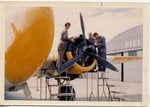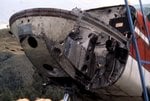iana
Recruit
Hi all, my first post, so here goes, I was intending to try to write a book, a fiction novel which depicts the life on a ww2 airbase, the staff, the hardships and about the unnoticed hero's that kept the pilots in the air. To date I have not seen a book like this. However I feel I have left the writing too long and all of those involved have faded away.
Having read many books on ww2 flying, to date I have not seen any reference to doing damage repairs, i.e. repairing bullet holes etc.
I know that in the aircraft carriers they carried components, hung of the hanger roof, such as elevators, tail-planes and wings, so I am thinking that no smallish airframe repairs were done, rather a component was changed over, or the aircraft sent to a reapir facilty, or just scrapped.
I suspect that the maintenance crew were only just able to do a turn around service to get the aircraft back into the air, with out worrying about small repairs.
Any thoughts on this?
Having read many books on ww2 flying, to date I have not seen any reference to doing damage repairs, i.e. repairing bullet holes etc.
I know that in the aircraft carriers they carried components, hung of the hanger roof, such as elevators, tail-planes and wings, so I am thinking that no smallish airframe repairs were done, rather a component was changed over, or the aircraft sent to a reapir facilty, or just scrapped.
I suspect that the maintenance crew were only just able to do a turn around service to get the aircraft back into the air, with out worrying about small repairs.
Any thoughts on this?




